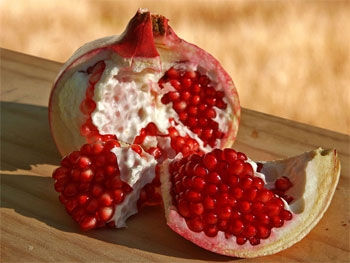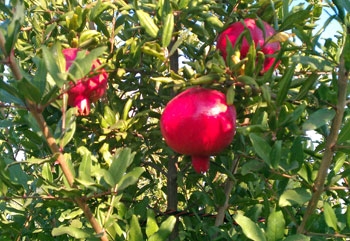The colorful, healthful pomegranate is a good food and lovely landscape plant
A jewel-toned garnish for California cuisine, antioxidant-rich elixir of good health, drought-resistant tree ideal for desert-like regions in California, the pomegranate has inner beauty and outward resiliency driving its growing popularity.
Pomegranates have been cultivated since ancient times, and are referred to poetically in texts ranging from the Bible to Shakespeare’s Romeo and Juliet. They are unusual among California fruit. Tough, leathery skin protects bright red, tart-sweet juice sacs, called arils, which are separated in groups by white spongy tissue. Inside each sac is an edible seed which contains fiber and unsaturated fat. The red pulp is a good source of potassium and vitamin C.
More a large shrub than a tree, with multiple trunks reaching a height of 15 to 20 feet, pomegranates are adapted to regions with cool winters and hot summers. Beautiful shiny foliage and a long flowering season make them attractive additions to coastal, inland valley and desert landscapes. Pomegranates tolerate a wide range of soil types, but prefer deep, well-drained loams. The best time to plant is in late winter or early spring – just before they leaf out.
Data about the scope of California commercial pomegranate production is hard to find. USDA stopped collecting pomegranate data in 1989 and CDFA groups pomegranates with kumquats, loquats, persimmons, prickly pears and other unusual fruit. UC Cooperative Extension farm advisor Maxwell Norton said county pesticide registration data indicate that five Central Valley counties – Kern, Fresno, Madera, Kings and Tulare – have about 35,000 acres planted to pomegranate. About 500 acres are planted in other counties combined. Kern County has the highest production with about 17,000 acres producing fruit valued at $115 million per year.
UC Cooperative Extension farm advisor Paul Vossen suggests the following standard varieties for backyard plantings:
- Ambrosia – Huge fruit, pale pink skin, similar to Wonderful
- Eversweet – Very sweet. Red skin, clear juice. Good for coastal areas
- Granada – Deep crimson fruit color. Matures early, but needs heat
- Ruby Red – Matures late, but not as sweet or colorful as Wonderful.
- Wonderful – Large, deep red fruit, large, juice red kernels. Small seeds.
For eating or juicing, select pomegranates at grocery stores by weight, not color. The heavier the pomegranate, the more juice inside. Some consumers are deterred from purchasing and eating the raw fruit because they believe it’s difficult to prepare. UC Master Food Preserver Geri Scalzi gives five simple steps that make eating fresh pomegranate easy:
- Cut off the top half an inch below the crown. Four to six sections of pomegranate arils divided by white membrane will be visible.
- Score the leathery skin with a sharp knife along each section.
- Break the pomegranate apart along the score lines. This can be done under water to prevent squirting pomegranate juice, which tends to stain clothing.
- Loosen arils and membranes and drop them into water. The arils will sink, the membranes will float. Skim off the membranes with a slotted spoon.
- Pour the arils and remaining liquid through a strainer.
The pulpy seed sacs are then ready to be eaten plain, tossed in salads, stirred into yogurt or sprinkled over cereal.
For more information on pomegranate production, attend a public meeting at the UC Kearney Agricultural Research and Extension Center, 9240 S. Riverbend Ave., Parlier, from 10 a.m to 1 p.m. Tuesday, Nov. 29. The following topics will be covered:
- Insect pest update, integrated pest management entomologist Walt Bentley
- Black heart disorder and tree decline issues, UC Davis plant pathologist Themis Michailides
- Interesting selections in the USDA germplasm collection, USDA national clonal germplasm representative Jeff Moersfelder
- Irrigation, fertigation & nitrogen use efficiency with drip irrigation, Claude J. Phené, USDA-ARS
- Summary of acreage trends, Merced County farm advisor Maxwell Norton
RSVP to Yolanda Murillo at ymurillo@ucdavis.edu or (559) 600-7285. The $10 registration fee may be paid at the door with cash or check. More information.



Posted by Pinoy Technologies on November 7, 2011 at 1:19 AM